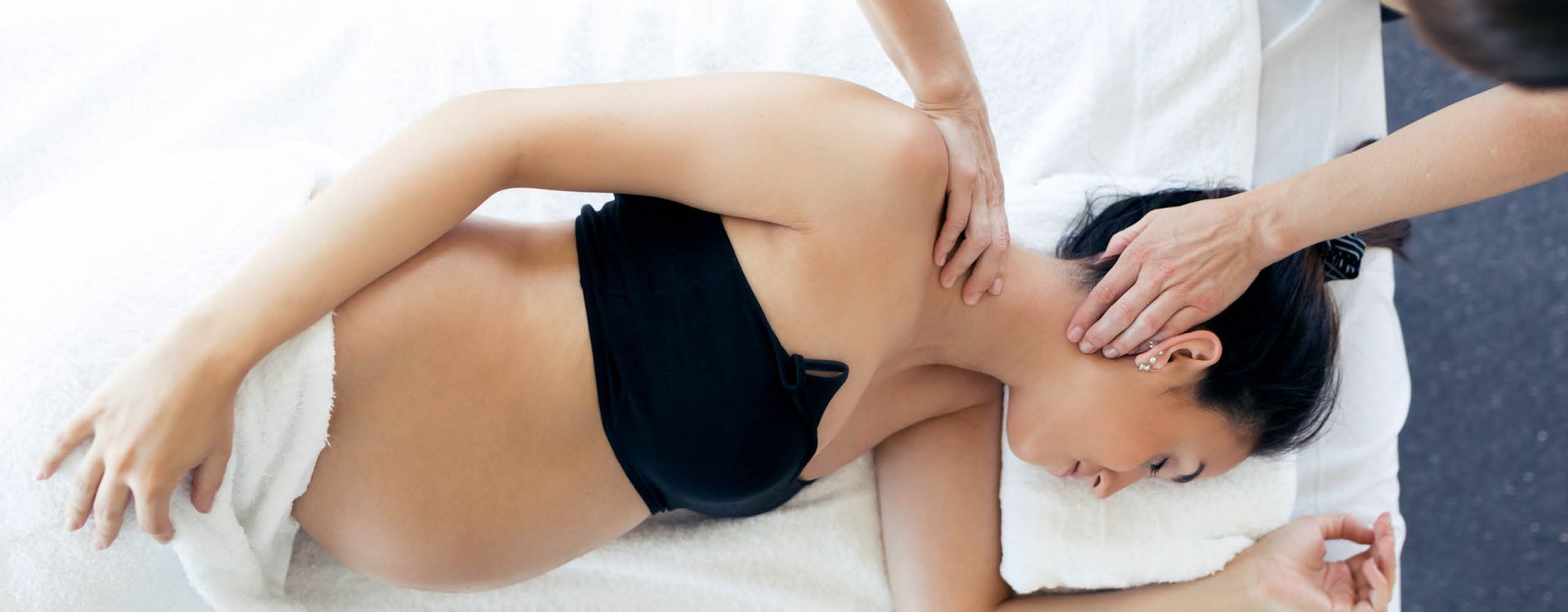Many women view cellulite — that dimpled, cottage cheese-like skin typically found on thighs, hips, and buttocks — as something abnormal and unappealing. Perhaps we’ve all seen too many air-brushed, hard-bodied women held up as the ideal in magazines and social media.
It may surprise you to learn that cellulite is normal, and it isn’t something only experienced by women with excess fat or women who are pregnant. While researchers don’t know exactly why cellulite forms, there are many factors believed to contribute to cellulite during pregnancy.
Here’s what we know about why cellulite forms, what you can do to avoid it during pregnancy, and some of the ways to minimize it after pregnancy.
What Is Cellulite?
Cellulite is a condition in which normal fat pushes up beyond connective tissue bands (septae) that tighten irregularly, leaving a dimpled or oatmeal-like texture on the surface of the skin.
It’s far more common among women due to the way our fat tissues are structured, and it’s most commonly seen where women carry their fat: on thighs, hips, and buttocks, and to a lesser extent on the abdomen, breasts, and upper arms. In fact, 80-90% of women post-puberty have some cellulite while less than 10% of men do [*].
Cellulite is not a serious medical condition, but in its most extreme forms, it can point to certain metabolic issues. There is research pointing to an association between the mechanisms of cellulite and lipedema, which is a chronic medical condition marked by an abnormal buildup of fat and connective tissue in the lower half of the body [*][*].
Clinically, there are three grades of cellulite:
-
Grade 1: The skin is smooth when standing or lying down but shows a dimpled configuration when pinched.
-
Grade 2: Skin appears dimpled when standing but smooth when lying down.
-
Grade 3: Skin is dimpled when standing or lying down, and dimpling is exaggerated by pinching.
While cellulite isn't painful physically, it can be emotionally distressing, diminishing a woman's self-esteem in profound ways — profound enough to fuel a cellulite treatment market valued at more than $2 billion in 2021 and estimated to reach $5.7 billion by 2031 [*].
While some oral, topical, therapeutic, and cosmetic treatments may have short-term benefits in reducing the appearance of cellulite, it’s important to understand that there is no miracle cure to completely remove cellulite.
Is It Normal to Get Cellulite During Pregnancy?
A woman’s body goes through a lot of changes during pregnancy, including storing fat for pregnancy and lactation. It is normal to get cellulite during pregnancy, although not all women do.
What Causes Cellulite During Pregnancy?
Truth is, the medical community doesn't fully understand why cellulite forms, but they have some idea of the contributing factors.
Genetics
If cellulite is a part of your DNA, there’s not a lot you can do about it. If you had cellulite before pregnancy, or your family members do, it’s reasonable to assume it may become more pronounced with pregnancy.
Hormonal Changes
The soaring estrogen levels pregnant women experience encourages their bodies to build up and store fat, which can lead to increasing pregnancy cellulite. Women are prone to develop cellulite during other high-estrogen periods, including puberty, when taking birth control pills, and postmenopausal hormone replacement therapy. (Not taking estrogen postmenopause can also result in more cellulite due to a reduction in collagen and elastin.)
Weight Gain
Weight gain is a normal and necessary part of every pregnancy, but it’s important not to let it get out of control as your eating habits (and cravings) change. Talk to your doctor about how much weight you should be gaining — and how quickly. Obesity in pregnancy increases the risk of pre-eclampsia and gestational diabetes, among other health concerns [*]. While cellulite can affect women of normal body weight as well as those who are overweight, it may appear more pronounced in the latter.
Poor Nutrition
You remember the old saying “you are what you eat”? Avoid fast foods or processed foods high in sugar, sodium, unhealthy fats, and empty carbohydrates, as these foods are linked to metabolic disorders that promote cellulite formation. Foods that cause you to retain water or lead to swelling or inflammation can exacerbate cellulite and add to your discomfort during pregnancy.
Lack of Physical Activity
A static lifestyle or a job that has you sitting or standing for long hours can lead to water retention, fat accumulation, and lack of muscle tone — all factors that promote cellulite to form.
Skin Elasticity and Age
Collagen protein accounts for 30% of your body’s protein, providing support to your muscles, bones, and connective tissue. In tandem with elastin, it gives our skin elasticity, volume, and moisture. Collagen diminishes naturally as we age, and can be further diminished by sun damage, smoking, and alcohol consumption. With the loss in skin elasticity, especially among women giving birth after age 35, cellulite can push into the dermis layer and become more pronounced.
Dehydration
Dehydration can prevent the body from metabolizing toxins in fat cells and lead to thinner, weaker skin. Thinner skin is more prone to cellulite.
Alcohol and Smoking
Alcohol and smoking can restrict blood flow, damage connective tissue, and diminish collagen production, in addition to harming your baby.
How to Reduce Cellulite During Pregnancy
The best way to reduce cellulite during pregnancy is to avoid making it in the first place. While genetics and hormones can throw an unpredictable wrench in the works, there is still a lot you can do to minimize the appearance of cellulite or help prevent it from forming. All of the following suggestions also lead to better health outcomes for mother and baby.
Eat Right and Watch Your Weight Gain
A diet including healthy omega-3 fatty acids, fruits, vegetables, and fiber, along with collagen-rich foods like bone broth, meat, and fish, can help reduce inflammation, excess fat accumulation, and help your skin stay supple during pregnancy.
Exercise
Going into your pregnancy fit and staying active during your pregnancy is one of the biggest ways to fight cellulite. Activities that promote blood flow, build strength, lengthen and tone muscles, promote light sweating, and make you feel good about your body are ideal.
Swimming (which can also help with skin elasticity during pregnancy) and yoga are ideal in this regard. You can do these activities during your entire pregnancy and even benefit from them during labor for pain management. Exercise that increases your muscle mass like cycling, running, or resistance training can help flatten cellulite as well. If you can’t find the time for the gym, do something at home (like dancing or brisk walking) that gets your heart rate up and gets you sweating [*].
While it’s important to maintain deep abdominal strength during pregnancy, it’s best to avoid crunches, heavy lifting, or exercises that can promote abdominal coning. Talk to your care team to determine what’s right for you and find a routine you can commit to.
Stay Hydrated
Drinking water doesn't equate to retaining water. Staying hydrated during pregnancy can help your body metabolize toxins in fat cells, improve connective tissue and promote supple skin — all things that help prevent cellulite.
Massage and Dry Brushing
Massage and dry brushing can leave you feeling invigorated thanks to the blood flow and lymphatic drainage they stimulate. Dry brushing helps detoxify skin, increase circulation, and promote lymph drainage. It will leave your skin smoother and softer without robbing it of moisture.
Combine dry brushing and massage for maximum effect: Before you shower, take your body brush (not a hairbrush, a soft bath brush or dry brush made for this purpose) and brush upward from your feet or ankles in long, gentle strokes. Not too hard — it should feel good. Use a circular motion when you get to your torso and back, and be gentle around the tender skin on your breasts (avoid the nipples) and upper arms especially. Follow with a shower to remove the dead skin cells and then use your favorite cream to massage from the feet up, following the same pattern of movement toward your heart.
While there’s no proof that dry brushing or massage eliminates cellulite, the plumping of the skin from enhanced circulation can reduce its appearance. And the enhanced blood flow and strengthening of the skin may help prevent it from forming [*].
Collagen Supplements
If your doctor approves, a collagen supplement may help your skin remain supple as it stretches to meet the demands of pregnancy. The research on collagen supplements is promising, but researchers aren’t exactly sure if it’s the collagen in them that promotes firmer, more supple skin or the peptides (like prolylhydroxyproline and hydroxyprolylglycine) collagen supplements may be packaged with [*].
Topical Creams and Lotions
Be sure to talk to your doctor before trying topical creams or lotions. They may seem innocent, but some contain caffeine or aminophylline, which can cause some people to become anxious or have a racing heart. Aminophylline cannot be used by people with asthma either.
Perhaps it goes without saying, but cosmetic treatments for cellulite during pregnancy are not a good idea.
Does Cellulite Go Away After Pregnancy?
Experts say you can’t completely get rid of cellulite, but don’t lose hope: After pregnancy, some women see a reduction in cellulite as they return to their normal weight. Others will need to take a more targeted approach to reduce it.
How to Treat Cellulite After Pregnancy
It may help to think of cellulite as a kind of scarring; No treatment can completely get rid of it but there are ways to reduce it, i.e., make it less noticeable.
Treatments to reduce cellulite divide into three basic categories: 1. things you can do for yourself, 2. non-invasive therapeutic interventions, and 3. cosmetic procedures performed on you by a board-certified professional.
Many of these treatments can be very pricey, and none are reported to last more than a few years. This list is by no means exhaustive.
What You Can Do Yourself to Reduce Cellulite
-
Lose your baby weight slowly to allow your skin to keep up with your weight loss.
-
Eat a good diet, minimizing processed foods, fats, sugars and empty carbs, and incorporating healthy fats and collagen-rich foods.
-
Drink plenty of water to keep your skin supple.
-
Exercise regularly, with a combination of aerobic, strength training, and stretching.
-
Get a good night’s sleep. This can be pretty challenging in the first few months, but be aware that disturbed sleep has a profoundly deleterious effect on metabolism and weight gain [*].
-
Dry brush and self-massage to stimulate circulation. (Foam rollers and fascia blasters may create swelling that offers only temporary improvement.)
-
Take an oral supplement with collagen peptides or conjugated linoleic acid (CLA), if your doctor approves [*][*][*].
-
Use a topical cream with tretinoin, which can stimulate collagen and elastin production, or retinol, which thickens the top layer of skin [*][*].
Non-Invasive Therapies That May Help Reduce Cellulite
-
Professional massage therapy can enhance lymphatic drainage.
-
Myofascial release therapy can help soften the tight connective tissue bands causing the dimpling and release trigger points that may hamper muscle function [*].
-
Infrared sauna offers a deeply penetrating light at red and near-infrared wavelengths that helps detoxify and stimulate collagen as it warms. As an added benefit, it can relax aching muscles, help with skin conditions, bolster immune support, and burn calories [*][*][*].
-
NormaTec compression therapy uses compressed air in sleeves that slide onto your arms, hips, or legs to bolster circulation, promote lymphatic drainage, and help athletes recover faster — with the added benefit of a highly pleasant, pneumatic, pressurized massage [*][*]. Compression stockings don’t offer the same benefits.
-
Radiofrequency, infrared light, or microwave therapy raises local blood circulation, boosts elastin and collagen proliferation, firms skin, and softens the tissue that strangles the fat lobules [*]. Side effects may include mild bruising and soreness that goes away. Most require multiple treatments and results last 3-6 months.
Cosmetic Surgery Procedures to Reduce Cellulite
-
Subcision is a minor, one-time surgical procedure in which a special needle or blade cuts and releases the fibrous band that's pulling down on the skin and creating the dimple. This procedure is purported to last 3 years or longer. Subcision is approved by the FDA under the names Avéli® and Cellfina® [*][*].
-
Laser treatments use a tiny laser probe that is inserted beneath the skin which heats the tissues to release some of the fibrous septae, diminish the thickness of the fat layer, and stimulate skin elasticity and collagen production. Lasts up to a year, and is branded as Cellulaze®.
-
Acoustic wave therapy delivers a shockwave via a steel-tipped device to break up fibrous tissue around cellulite and stimulate collagen and elastin. Results in one study lasted at least 6 months [*].
Cellulite and Pregnancy FAQs
Is cellulite related to cellulitis?
No. Cellulitis is a common bacterial skin infection that causes redness, swelling, and pain, often around the feet and legs.
What is the best way to avoid getting cellulite during pregnancy?
Eat a healthy diet, monitor your weight gain, stay hydrated, and exercise regularly.
Can I treat my cellulite while I’m pregnant?
Simple measures like dry brushing, massage, staying hydrated, monitoring your weight gain, and exercise are easy and have other health benefits. Talk to your doctor about any oral supplements, topical creams, or therapeutic procedures you may be considering, and to formulate an exercise plan. Cosmetic procedures are not advised, and you should not try to lose weight on account of cellulite during pregnancy. Your body needs the extra body fat and fluids.
How much does it cost to have Cellfina, Avéli or Cellulaze?
Cellfina can range from $3,000-$6,000 per treatment. Avéli can range from $3,000 to $5,000. Cellulaze can cost anywhere from $2,500-$9,000.
Who can perform subcision or laser treatments?
You should only use a board-certified plastic surgeon for these procedures.
How much does radiofrequency therapy cost?
Anywhere from $200-$700 per treatment. It may take 4-10 treatments to see results, and monthly treatment to maintain results.
Who is a good candidate for cellulite reduction treatments?
The American Academy of Cosmetic Surgery states that ideal candidates for cellulite treatment are in good health overall, happy with their current weight, have light-colored skin (which makes cellulite more noticeable), and understand that available treatments can only reduce the appearance of cellulite, not eliminate it entirely.
Before spending a fortune on cosmetic surgery for cellulite, be sure to take a look at the before and after photos in NIH-published studies. While many women report being satisfied with such treatments, the differences between the before and after states can be pretty subtle [*].
In the long run, cosmetic surgery is not a substitute for healthy lifestyle choices.
The Bottom Line
We’d all love to have an awesome beach bod but the reality is that our bodies are roadmaps that tell the story of our lives: where we came from, our challenges, our health, and our lifestyle.
Pregnancy changes a woman’s body dramatically over a relatively short time frame, a fact some women find amazing and others find distressing [*]. Instead of beating yourself up over a little extra cellulite during or after your pregnancy, you could focus on your health and celebrate the fact that you survived a global pandemic and created a life within your amazing body.
Invest in Your Family’s Health Wisely
MiracleCord offers affordable, industry-leading cord blood and cord tissue banking services. The stem cells we capture and store can be used in more than 80 FDA-approved treatments for blood diseases, cancers, immune system disorders, and metabolic disorders. And there are more than 700 stem cell clinical trials in progress.
Saving your baby’s cord blood and tissue may be the best decision you make for your family. Learn more by requesting our Free Info Kit or call 888.743.2673 to speak to one of our knowledgeable customer service representatives.
DISCLAIMER: THE INFORMATION ON THIS WEBSITE IS NOT INTENDED TO BE USED AS MEDICAL ADVICE.The materials and information contained on the MiracleCord website is provided for educational and informational purposes only, and is not intended to, and does not constitute, medical or other health advice or diagnosis, and should not be used as such. You should not use this information to diagnose or treat a health problem or disease. If you are seeking personal medical advice, you should consult with a licensed physician. Always consult with a qualified health care provider regarding a medical condition.




